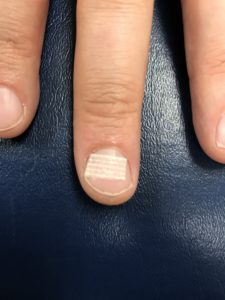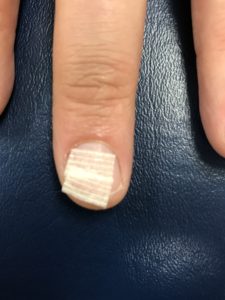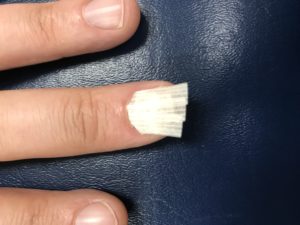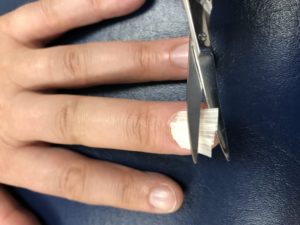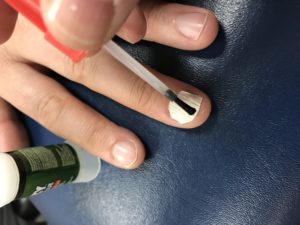By: Mark Vinson, MEd, ATC, CSCS, Assistant Athletic Trainer, Tampa Bay Rays
Blisters
One sports injury that is unique to baseball is a blister on a pitcher’s finger. Typically blisters form on the middle finger of the pitching hand since this is the last contact point as the ball is released for a fastball. Blisters can also form on the index finger or the thumb, depending on a pitcher’s grip for other pitches.
The friction created between the ball’s seams and the tip of the finger can lead to irritation and eventually form a blister. In addition to being painful, blisters on pitching fingers can lead to a lack of command as a result of the adjustments a pitcher may make to avoid irritation with each pitch.
There are several causes of blisters on pitching fingers, including changes in grip, but the most common is pitching in a humid environment. Skin friction with the ball is increased when the hand gets damp due to perspiration or moisture in the air. There are ways to help offset this moisture though.
To aid in the prevention of blisters, some pitchers use spray-on antiperspirant, which has been shown to help prevent sweat and reduce added moisture from sweat.1 The antiperspirant is sprayed over the hand and fingers and may be reapplied between innings.
Some starting pitchers place their pitching hand into a bag of rice in between innings to help reduce moisture on their fingers. The rice absorbs moisture and prevents the “pruning” of the fingers that can occur with prolonged moisture.
Prevention of blisters is vital; however, once one has formed, there are various ways to treat it. Pitchers who frequently suffer from small blisters may be accustomed to draining the blister using a sterile syringe.2 When using this method, caution must be ensured. First, prep and clean the skin thoroughly. When draining, use extreme care to only penetrate the top layer of the blister, which will help avoid infection. Drainage provides immediate relief, but if the pitcher remains in the game, monitor the blister to ensure that it does not create a skin avulsion (open wound) and to confirm that a second blister does not form underneath the original.
Other treatments include covering the blister with skin adhesives, such as Dermabond or Super Glue. However, these adhesives may need to be reapplied throughout the game. Liquid bandages do not hold up well to the force pitchers produce.
Once a pitcher has been removed from the game, treatment typically consists of drainage of the blister if it is still intact. Soaking the finger in a mixture of warm water and Betadine solution for 5 to 10 minutes is also helpful. The Betadine helps to clean the area, prevent infection and toughen the skin around the affected area over the long-term.
Creams and salves have been developed to aid in promoting blister healing. These mixtures use a mixture of alum powder and tincture of benzoin. Traditional antibiotic ointments and creams should be avoided as they tend to soften the skin around the affected area.
Fingernail Fractures
Another common injury for pitchers is fingernail fracture. A fracture typically occurs on the nail of the middle finger and can occur in vertical or horizontal fashion. Again, the fracture occurs due to the repetitive pressure of the ball coming off the tip of the finger. Treatment for the fracture involves a nail cast made of Steri-Strips that are cut and placed perpendicular to the fracture (Fig. 1 and 2).
A second layer of Steri-Strips is then placed perpendicular to the original set of strips to create a cross-hatch effect (Fig. 3). The strips are then trimmed along the nail (Fig. 4).
Super Glue is then applied to the Steri-Strips (Fig. 5). Allow the Super Glue to dry and then reapply. Repeat for 3 to 4 applications. Any imperfections can be gently filed down using a nail file.
Athletic trainers working with pitchers face unique challenges to prevent and treat blisters and other hand injuries, but with some creative thinking, there are solutions.
References
- Reynolds, K., Darrigrand, A., Roberts D., Knapik, J. 1995. Effects of an antiperspirant with emollients on foot-sweat accumulation and blister formation while walking in the heat. Journal of American Academy of Dermatology. Volume 33: Pages 626-630.
- Dawson, C., Bancells, R., B Ebel, B., Bergfield, W., McFarland, E. 2004. Treatment of Friction Blisters in Professional Baseball Players. Vol. 9: Pages 62-65.

